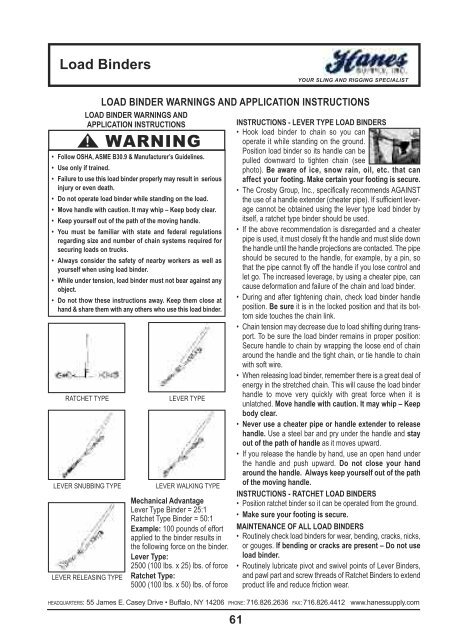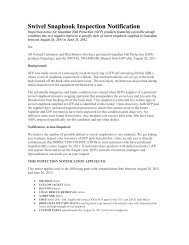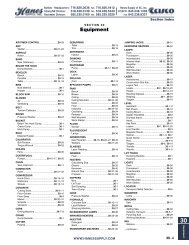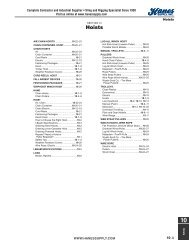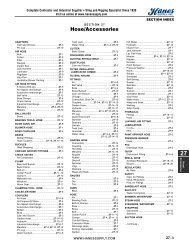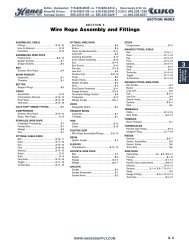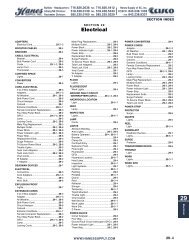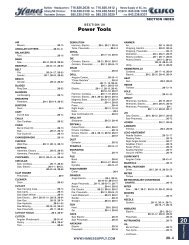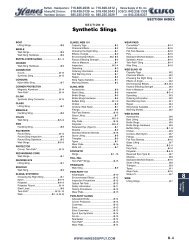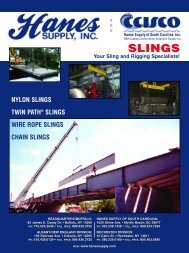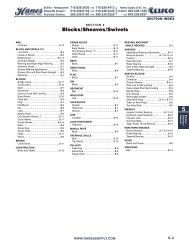twin-path® slings in action - Hanes Supply, Inc
twin-path® slings in action - Hanes Supply, Inc
twin-path® slings in action - Hanes Supply, Inc
- No tags were found...
Create successful ePaper yourself
Turn your PDF publications into a flip-book with our unique Google optimized e-Paper software.
load b<strong>in</strong>dersYOUR SLING AND RIGGING SPECIALISTLOAD BINDER WARNINGS AND APPLICATION INSTRUCTIONSLOAD BINDER WARNINGS ANDAPPLICATION INSTRUCTIONS!• Follow OSHA, ASME B30.9 & Manufacturer’s Guidel<strong>in</strong>es.• Use only if tra<strong>in</strong>ed.• Failure to use this load b<strong>in</strong>der properly may result <strong>in</strong> serious<strong>in</strong>jury or even death.• Do not operate load b<strong>in</strong>der while standIng on the load.• Move handle with caution. It may whip – Keep body clear.• Keep yourself out of the path of the mov<strong>in</strong>g handle.• You must be familiar with state and federal regulationsregard<strong>in</strong>g size and number of cha<strong>in</strong> systems required forsecur<strong>in</strong>g loads on trucks.• Always consider the safety of nearby workers as well asyourself when us<strong>in</strong>g load b<strong>in</strong>der.• While under tension, load b<strong>in</strong>der must not bear aga<strong>in</strong>st anyobject.• Do not thow these <strong>in</strong>structions away. Keep them close athand & share them with any others who use this load b<strong>in</strong>der.RATCHET TYPELEVER SNUBBING TYPELEVER RELEASING TYPEWARNINGLEVER TYPELEVER WALKING TYPEMechanical AdvantageLever Type B<strong>in</strong>der = 25:1Ratchet Type B<strong>in</strong>der = 50:1Example: 100 pounds of effortapplied to the b<strong>in</strong>der results <strong>in</strong>the follow<strong>in</strong>g force on the b<strong>in</strong>der.Lever Type:2500 (100 lbs. x 25) lbs. of forceRatchet Type:5000 (100 lbs. x 50) lbs. of forceINSTRUCTIONS - LEVER TYPE LOAD BINDERS• Hook load b<strong>in</strong>der to cha<strong>in</strong> so you canoperate it while stand<strong>in</strong>g on the ground.Position load b<strong>in</strong>der so its handle can bepulled downward to tighten cha<strong>in</strong> (seephoto). Be aware of ice, snow ra<strong>in</strong>, oil, etc. that canaffect your foot<strong>in</strong>g. Make certa<strong>in</strong> your foot<strong>in</strong>g is secure.• The Crosby Group, <strong>Inc</strong>., specifically recommends AGAINSTthe use of a handle extender (cheater pipe). If sufficient leveragecannot be obta<strong>in</strong>ed us<strong>in</strong>g the lever type load b<strong>in</strong>der byitself, a ratchet type b<strong>in</strong>der should be used.• If the above recommendation is disregarded and a cheaterpipe is used, it must closely fit the handle and must slide downthe handle until the handle projections are contacted. The pipeshould be secured to the handle, for example, by a p<strong>in</strong>, sothat the pipe cannot fly off the handle if you lose control andlet go. The <strong>in</strong>creased leverage, by us<strong>in</strong>g a cheater pipe, cancause deformation and failure of the cha<strong>in</strong> and load b<strong>in</strong>der.• Dur<strong>in</strong>g and after tighten<strong>in</strong>g cha<strong>in</strong>, check load b<strong>in</strong>der handleposition. Be sure it is <strong>in</strong> the locked position and that its bottomside touches the cha<strong>in</strong> l<strong>in</strong>k.• Cha<strong>in</strong> tension may decrease due to load shift<strong>in</strong>g dur<strong>in</strong>g transport.To be sure the load b<strong>in</strong>der rema<strong>in</strong>s <strong>in</strong> proper position:Secure handle to cha<strong>in</strong> by wrapp<strong>in</strong>g the loose end of cha<strong>in</strong>around the handle and the tight cha<strong>in</strong>, or tie handle to cha<strong>in</strong>with soft wire.• When releas<strong>in</strong>g load b<strong>in</strong>der, remember there is a great deal ofenergy <strong>in</strong> the stretched cha<strong>in</strong>. This will cause the load b<strong>in</strong>derhandle to move very quickly with great force when it isunlatched. Move handle with caution. It may whip – Keepbody clear.• Never use a cheater pipe or handle extender to releasehandle. Use a steel bar and pry under the handle and stayout of the path of handle as it moves upward.• If you release the handle by hand, use an open hand underthe handle and push upward. Do not close your handaround the handle. Always keep yourself out of the pathof the mov<strong>in</strong>g handle.INSTRUCTIONS - RATCHET LOAD BINDERS• Position ratchet b<strong>in</strong>der so it can be operated from the ground.• Make sure your foot<strong>in</strong>g is secure.MAINTENANCE OF ALL LOAD BINDERS• Rout<strong>in</strong>ely check load b<strong>in</strong>ders for wear, bend<strong>in</strong>g, cracks, nicks,or gouges. If bend<strong>in</strong>g or cracks are present – Do not useload b<strong>in</strong>der.• Rout<strong>in</strong>ely lubricate pivot and swivel po<strong>in</strong>ts of Lever B<strong>in</strong>ders,and pawl part and screw threads of Ratchet B<strong>in</strong>ders to extendproduct life and reduce friction wear.HEADQUARTERS: 55 James E. Casey Drive • Buffalo, NY 14206 PHONE: 716.826.2636 FAX: 716.826.4412 www.hanessupply.com61


